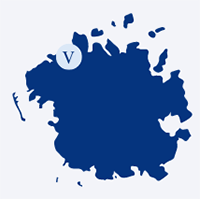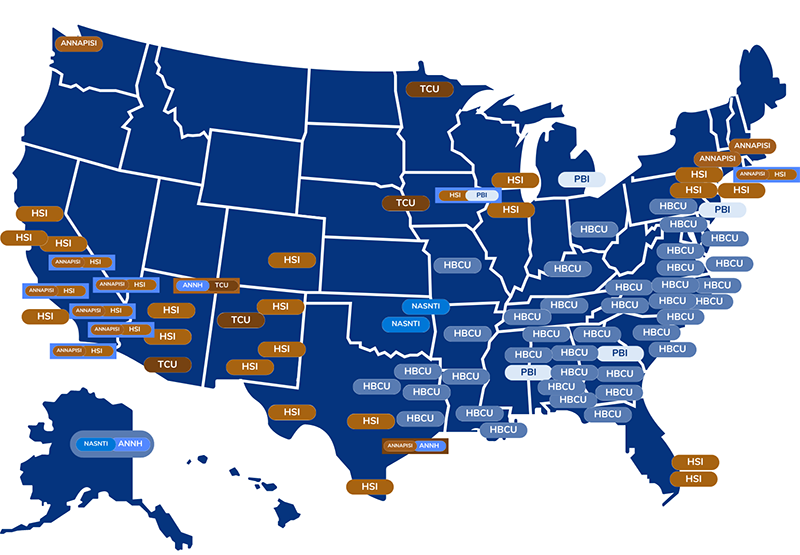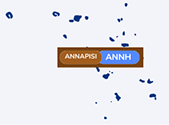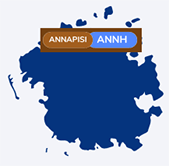Connecting Minority Communities Pilot Program
Office of MinorityBroadband Initiatives
Program Goal
OMBI is working to directly address the lack of broadband access, connectivity, adoption, and equity to close the digital divide. Connecting Minority Communities (CMC) Pilot Program is a $268 million grant program authorized through the CAA 2021. Through the CMC Pilot Program, NTIA is directly addressing the lack of broadband access, connectivity, adoption and equity at our nation’s HBCUs, TCUs, and MSIs, and in their surrounding anchor communities. Accordingly, Congress has directed NTIA to provide grants to HBCUs, TCUs, and MSIs to facilitate educational instruction and learning, including through remote instruction. These grants also support consortia including MBEs and tax-exempt 501(c)(3) organizations. The CAA 2021 identifies HBCUs, TCUs, and MSIs as defined in the Higher Education Act of 1965.
Types of Eligible Recipient Institutions
Historically Black College and University (HBCU):
A HBCU is “any historically black college or university that was established prior to 1964, whose principal mission was, and is, the education of black Americans, and that is accredited by a nationally recognized accrediting agency or association…”
Tribal College and University (TCU):
A TCU is an institution that either I) qualifies for funding under the Tribally Controlled Colleges and Universities Assistance Act of 1978 or the Navajo Community College Act or II) is cited in section 532 of the Equity in Educational Land-Grant Status Act of 1994.
Minority Servicing Institutions (MSIs) include:
- Asian American and Native American Pacific Islander Serving Institution (AANAPISI):
An AANAPISI is an institution with an undergraduate enrollment of at least 10% Asian and Pacific Islander American students and with at least 50% of students from low-income backgrounds. - Alaska Native and Native Hawaiian Serving Institution (ANNH):
An ANNH is an institution with either at least 20% Alaska Native students or at least 10% Native Hawaiian students. - Hispanic-Serving Institution (HSI):
A HSI is an “accredited, degree-granting public or private not-for-profit institution of higher education with 25% or more total undergraduate Hispanic full-time equivalent student enrollment.” - Native American-Serving Nontribal Institution (NASNTI):
A NASNTI is an institution that is not affiliated with American Indian and Native Alaskan tribes but still enroll at least 10% of Native American undergraduate students and receive funding to serve Native American students. - Predominantly Black Institution (PBI):
A PBI is an institution that serves at least 1,000 undergraduate students, has at least 50% low-income or first-generation students, and enrolls at least 40% African American students.
More than a broadband program, the CMC Pilot Program aims to tackle one of the toughest economic challenges of our time—bringing people off the sidelines and into the labor market with
the skills employers need. The CMC Pilot Program grants aim to serve three purposes to build
capacity in eligible institutions, their surrounding communities, and their students:
- Provide broadband Internet access service, including the installation or upgrade of broadband facilities on a one-time capital improvement basis to increase or expand broadband capacity and/or connectivity at the eligible institution;
- Purchase or lease eligible equipment and devices for student or patron use, subject to any restrictions and prohibited uses; and
- Hire and train information technology personnel who are a part of the eligible anchor institution, MBE, or tax-exempt 501(c)(3) organization.
Connecting Minority Communities Pilot Program
CMC Funding Purposes
Purchase high speed Internet service.
Purchase or lease eligible equipment and devices for student or patron use.
Hire and train information technology personnel.
CMC Expected Benefits
Expand educational instruction and remote learning opportunities.
Spur economic development, and entrepreneurship.
Increase institutional capacity.
The funds, used for these three purposes, lead the anchor institutions to expand educational instruction and remote learning opportunities, spur economic development and entrepreneurship, and increase institutional capacity to close the digital divide. In addition, the CMC Pilot Program took a modern approach to the grant program—applicants stated the problem and their proposed solutions within the application. This method allowed for innovative approaches to solve problems in their communities.
While the authorizing legislation describes the goal and the allowable use of funds, each applicant presented the path, consistent with the authorizing legislation, to achieve the goals of the program that would be most effective for their community. Anchor institutions proposed projects that meet the needs of their communities, including local cultural and environmental contexts.
For example, one CMC grant recipient, New Mexico Highlands University, a Hispanic Serving Institution serving northern New Mexico, is building a digital skills training curriculum with stackable micro-credentials in an open education resource model grounded in Acequia and Land Grant Education (ALGE) perspectives that infuse the local New Mexico heritage.
Another CMC grant recipient, Tohono O’odham Community College, a Tribal College in rural southern Arizona, designed a broadband needs assessment for the O’odham Tribal members and conducted the survey in both English and O’odham, launching the initial survey at the Annual Rodeo.
Program Highlights
In the past year, OMBI fully awarded the federal funding for the CMC Pilot Program. Eligible institutions showed significant interest in the program. In total, OMBI received over 200 applications, requesting over $833 million in funding, which was well above the $268 million allocated by Congress for the CMC Pilot Program.
This strong response and the needs expressed in the applications to the CMC funding opportunity demonstrates the scope, need, and interest by anchor institutions to expand digital access to their surrounding communities. OMBI is maintaining relationships with these applicants to connect them to other funding opportunities and key broadband stakeholders in their states.
$833M
Funds Requested in CMC Grantee Applications
$268M
Funds Obligated to CMC Grantees
In total, OMBI made 93 awards to eligible HBCUs, TCUs, MSIs, and consortia, obligating the full $268 million in available funds. Grantees represent 36 states and territories including:
- American Samoa,
- Federated States of Micronesia,
- Marshall Islands, and
- Puerto Rico.
The grants rolled out in five phases:
Phase I: Began on August 1, 2022, and included 5 awards.
Phase II: Included 14 awards.
Phase III: Included 12 awards.
Phase IV: Brought 26 awards.
Phase V: Started seven months later on March 1, 2023, and included 36 awards.
Applicants were evaluated across five categories:
- Project Purpose;
- Project Needs and Benefits;
- Project Viability and Innovation;
- Project Budget; and
- Project Evaluation.2
Number of Awards, Award Amounts, Award Recipients
93
Awards made to eligible HBCUs, TCUs, MSIs and consortia.
$268M
Obligated in CMC grants.
36
States and territories represented by grant recipients.
CMC Grant Recipients Map






*Maps have been enlarged to show detail.
Timeline Key: (August 1, 2022 - March 1, 2023)
(5 grantees)
(14 grantees)
(12 grantees)
(26 grantees)
(36 grantees)

The CAA 2021 stipulated that no less than 40% of the amount of CMC grants be awarded to OMBI FY2023 ANNUAL REPORT Page 22 of 55 HBCUs. The CMC program successfully exceeded this benchmark with 46% of awards going to HBCUs. In total, CMC awarded grants to 43 Historically Black Colleges and Universities, 31 Hispanic Serving Institutions, 21 Minority Serving Institutions, and 5 Tribal Colleges or Universities. The full listing of the CMC Pilot Program grantees and their institutional designations are included in the Appendix.
In addition, the CAA 2021 also required that no less than 20% of the amount of the grants be used by eligible recipients to provide broadband Internet access service or eligible equipment to their students. The CMC program successfully exceeded this benchmark with 91% of funds to be used for this purpose.
CMC Grant Designations Map






*Maps have been enlarged to show detail.
Designation Types Key
Designation Types (Multiple) Key
Community Innovative Approaches to Increasing Internet Access
The diversity of innovative approaches to closing the digital divide and increasing access proposed in the CMC program applications reflects the diverse needs, context, assets, relationships, and partnerships in each anchor community. These community-driven innovative approaches demonstrate that one-size does not fit all.
Increasing Internet access across diverse communities requires local community solutions to overcome the barriers anchor institutions face. CMC funds are allocated to: improve infrastructure and IT capacity at the institutions to subsidize high-speed Internet connections through hotspots, laptops, and other devices; provide workforce training including credentials in cybersecurity, fiber-optic installation, computer skills training and more; enhance digital literacy skills for students, community members, and anchor institution staff; furnish technology hubs; provide internships and apprenticeships; and expand online learning capacity at anchor institutions. The chart below shows the breakdown of the various approaches taken by CMC grantees. Most grantees incorporate a combination of multiple approaches. See Appendix for detail on the approaches used by each grantee.
74%
Workforce Training | Economic Growth
61%
Classroom Technology Upgrades
35%
Internships | Apprenticeships
29%
STEM | STEAM
70%
Digital Literacy Skills
46%
Community Technology HUB | Upgrade
24%
Entrepreneurship | Small Business
23%
Cybersecurity
13%
Telehealth | Telemedicine
Many anchor institutions designed a combination of approaches to define their programs and meet the needs of their surrounding communities. Three common approaches are workforce development, digital literacy skills, and increasing adoption overall. The following are four innovative stories illustrating how CMC funding is being used within anchor institutions and their surrounding anchor communities to help close the digital divide.
Innovation to Build the Talent Pipeline
The Huntsville-Madison region of northern Alabama is home to a fast growing, highly technical aerospace and defense industry. While the overall area has a record of steady economic growth, the benefits of this growth are not shared equally. Founded in 1961, Drake State Community and Technical College is an Historically Black College serving historically underserved and low-income communities by offering degrees in high-demand technical and vocational fields including computer science information systems and cybersecurity. The Drake State Project is working to improve home broadband access and connectivity to students, better the online learning experience, and improve student access to resources and services. At the time of this report, Drake State has procured 425 LTE-enabled laptops and 425 hotspots to loan to students. Drake State’s partnership with Western Governors University allows for matriculation to bachelor’s degree programs in information technology management. Combined with Drake State’s dual enrollment for local high school students, Drake State serves as a powerful conduit for a talent pipeline prepared to tap into the economic opportunities in the region.
Increasing Access to Broadband Overall: A Laptop of One’s Own
The 27,000 square miles of Navajo Nation is a historically underserved region. Home to 175,000 registered Tribal members, the median household income is $28,052. Diné College’s Connect Navajo project aims to improve educational and economic opportunity on the Navajo Nation by improving Internet access, providing more hardware, and investing in IT staff. Founded in 1968 as Navajo Community College, Diné College works to advance quality post-secondary student learning and development to ensure the well-being of the Diné people. Connect Navajo works to increase student access to the Internet through broadband subscriptions and hotspots, provide laptops to students, and enhance staff technical skills. As of this report, Connect Navajo has donated 225 laptops and 100 Wi-Fi hotspots to students. To increase the power and pride of owning one’s own laptop and Internet device, Connect Navajo is granting the devices to students.
Digital Literacy Skills: Embedding Digital Literacy and Skills Training in the Community
Esperanza College of Eastern University (ECEU) is a branch campus of Eastern University located in the heart of Latino North Philadelphia and Philadelphia’s only Hispanic-Serving Institution (HSI). ECEU serves a student population that is 84% Latino, 97% low income, and 80% the first generation to attend college. Eastern University’s Hope Digital Literacy project works to educate, equip, and empower the predominantly Latino community to use digital tools to accomplish workforce, education, and health-related goals. The Hope Digital Literacy Project is establishing a digital literacy hub at ECEU to serve as a community drop-in site for one-on-one support and offer digital skills training for both students and members of the broader community. At the time of this report, the digital literacy hub is coming into shape with the selection of a dedicated Community Digital Resource Project Director, strong community partners, and the launch of a digital needs assessment to shape the hub’s programming.
2 Full detail on the evaluation criteria is available in the Connecting Minority Communities Pilot Program Notice of Funding Opportunity (2021).
